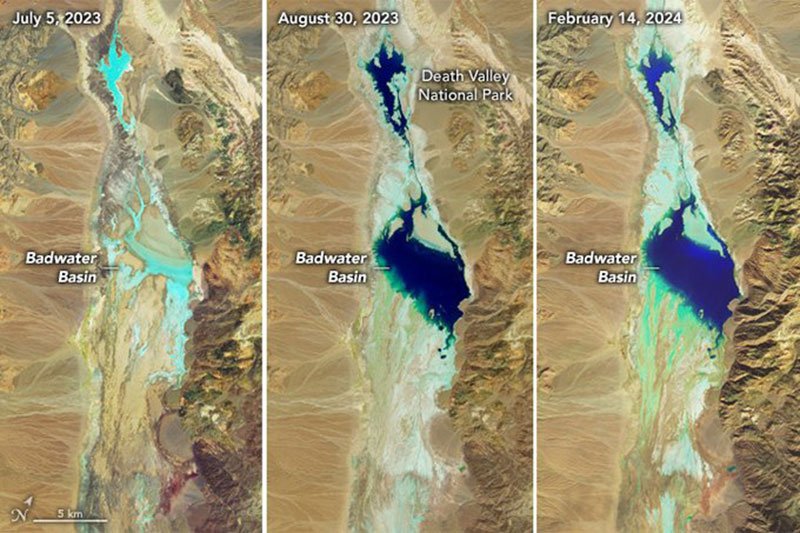
In a remarkable turn of events, NASA has unveiled striking before-and-after satellite images showcasing the unexpected formation and persistence of a temporary lake in Death Valley, one of the hottest and driest places on Earth. The astonishing visuals captured by NASA’s Earth observatory reveal the Badwater Basin in Death Valley undergoing a dramatic transformation, evolving from its arid state to a sizable temporary lake.
This temporary lake in Death Valley is extending its stay.
Rain from a potent atmospheric river filled up the Badwater Basin this month. These enhanced-color #Landsat images show a shallow lake several kilometers across, with water emphasized in blue. https://t.co/YXeTZT6oGG pic.twitter.com/h5vVfpQSjU
— NASA Earth (@NASAEarth) February 16, 2024
The unusual phenomenon was triggered by Hurricane Hilary in August 2023, leading to the creation of the ephemeral lake. Despite expectations that it would gradually dissipate, the water body endured through the fall and winter. A twist in the narrative occurred in February 2024 when a potent atmospheric river refilled the lake, capturing the attention of scientists and nature enthusiasts alike.
The NASA post on this remarkable occurrence reads, ”This temporary lake in Death Valley is extending its stay. Rain from a potent atmospheric river filled up the Badwater Basin this month. These enhanced-color #Landsat images show a shallow lake several kilometers across, with water emphasized in blue.”
Death Valley, known for receiving a mere 2 inches of rain per year, experienced an extraordinary phenomenon as more than double that amount fell within the past six months, primarily due to the remnants of Hurricane Hilary and the influence of an atmospheric river. The satellite imagery suggests that the lake has reached a comparable size in February 2024 as it did in its initial formation in August 2023, defying expectations and extending its months-long tenure.
As of February 14, park officials report that the lake reaches depths of up to 1 foot in certain areas, raising questions about its longevity. Abby Wine, a ranger in Death Valley National Park, expressed surprise at the lake’s persistence, stating, ”Most of us thought the lake would be gone by October. We were shocked to see it still here after almost six months. This week’s rain will extend how long the lake is here.”
The unforeseen and prolonged existence of this temporary lake challenges our understanding of the region’s extreme aridity, offering a glimpse into the dynamic and resilient nature of Earth’s landscapes.
